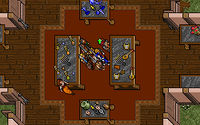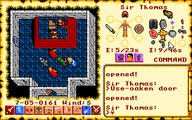Artisan's Guild
The Artisan's Guild of Minoc (also known as the Artist's Guild) is a collective of artists, musicians and tinkers operating in concert for the benefit of the group. First founded prior to Ultima VI, the group persisted for nearly two centuries, disappearing sometime after the events of Ultima VII.
History[edit]
Age of Enlightenment[edit]
Initially appearing to have a theme of musicality to its ranks, the Avatar first encountered the Artisan's Guild in Ultima VI, when it was headed by the lutenist Selganor. As the hero had need of joining its ranks so as to obtain the rune of Sacrifice, the champion of virtue found it necessary to perform the rituals of its initiation, which consisted of playing the folk song "Stones" on a set of yew panpipes before receiving an accolade with the handle of the guildmaster's lute. As the Avatar's former companions, Julia and Gwenno, were already both members in good standing, the pair proved more than willing to assist the hero in this endeavor.[1]
Age of Armageddon[edit]
Over the next two centuries, the guild slowly became more focused on craftsmanship rather than performance, with the group becoming more akin to modern artist collectives, sharing living and studio space in a large cross-shaped guild hall. By Ultima VII, the position of guildmaster had fallen to Gladstone, a stern glassblower and potter. Struggling under the burdens of uneven taxation by the Britannian Tax Council, the assembly of craftspersons had fears of bankruptcy at the time the Avatar again visited their city – their financial problems compounded by an ongoing feud with the local Fellowship branch over the construction of a commissioned monument for Owen, a local celebrity shipwright. Fearing that the shift in the economy brought on by the monument would create a dramatic rise in material prices, many worried that the guild would not long be able to sustain itself.[2]
Should the Avatar investigate claims that Owen's craftsmanship was fundamentally faulty, the hero could uncover designs which proved that numerous ships made by the shipwright had been ill-proportioned and prone to capsizing, and that several of these had been involved in fatal wrecks. If the mayor of Minoc at the time, Burnside, was confronted with this reality, the official could be convinced to cancel the statue, after which the guild would be asked to create a piece of public art to fill its empty pedestal.[3][4][2]
Regardless of this seeming windfall, the following years were not kind to Minoc or the Artisan's Guild. The shifts of the Imbalance and the Great Cataclysm destroyed the original City of Sacrifice, and the new settlement bearing its name on Dagger Isle had no similar groups within it, its populace decimated by riots and murderous rituals.
Lore[edit]
| “ | I suppose I should get to Minoc more than I do, as it is the home of the artisans guild. The glassblower, the clockmaker, the basket weaver, they all go to Selganor for guidance, and I must admit I've picked up a tip or two from the man myself. Absent-minded he may be, but he knows how to coax magic out of a lute. I hear your old friend Gwenno is helping out with guild business, and Julia is living up there as well. – from The Book of Prophecy (Ultima VI)
|
|---|
| “ | This thriving seaport is located in northern Britannia at the mouth of Lost Hope Bay. Minoc, also known as the City of Sacrifice, has an active sawmill, armourer, shipwright and branch of the Britannian Mining Company. It is the home of the Artist's Guild, where craftsmen of all types display their craft. – from The Book of Fellowship (Ultima VII)
|
|---|
| “ | If thou dost seek a craftsman or craftswoman, thou hast come to the right place. We have a tinker, Julia, who understands the construction of any contraptions thou canst conceive of, a blacksmith who makes the finest horseshoes I have ever seen, a clockmaker, a sawyer, a candlestick maker and a glassblower who also sculpts — me! Mayor Burnside says Minoc has the largest and best collection of artisans in all of Britannia, and I am want to believe him. However, as prices rise in parts of the city, some guild members will be forced out. No one will be able to afford our work when one is paying too much for other necessities. – from Key to the Black Gate (Ultima VII)
|
|---|
Members[edit]
Ultima V: Lazarus[edit]
Ultima VI[edit]
- Selganor: guildmaster and lutenist
- Dale: glassblower
- Gwenno: bard and bowyer, working on the transcription of traditional Britannian folk music
- Julia: tinker and maker of various musical instruments
- Michelle: basket weaver
- Troy: clockmaker
Ultima VII[edit]
Ultima V: Lazarus[edit]
This is an Ultima V: Lazarus-related article or section. The information within may not apply to Ultima V or other Ultima games.
In Ultima V: Lazarus, the Artisan's Hall stood in the center of town, to the west of The Bay Inn. It was here that Lyvia and Woodroffe rented space to ply their trade.
Trivia[edit]
- In Ultima VI, Stivius makes mention of "guild language" when referring to the poetic speech of Horance, implying that the sorcerer may have once participated in the Guild.[5]
- In reality, crafting panpipes out of yew wood would be very ill-advised, as all members of the taxus genus contain highly poisonous alkaloids which can sicken and even kill humans.[6]
Gallery[edit]
References[edit]
- ↑ Selganor. Underworld Dragon’s Ultima VI transcript. Ultima VI. "678987, 8767653, artisan, join, guild, loan, member, panpipes, rune, stones".
- ↑ 2.0 2.1 Gladstone. Underworld Dragon’s Ultima VII transcript. Ultima VII. "Artist's Guild, events, Minoc, monument, power, worst".
- ↑ Karl. Underworld Dragon’s Ultima VII transcript. Ultima VII. "brother, Owen".
- ↑ Burnside. Underworld Dragon’s Ultima VII transcript. Ultima VII. "damage, deaths, plans".
- ↑ Stivius. Underworld Dragon’s Ultima VI transcript. Ultima VI. "alchemist, guild, Horance, language".
- ↑ “Taxus”. Wikipedia. Retrieved 2011-03-04.

